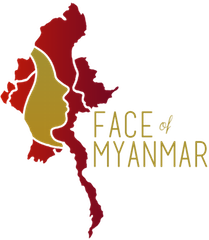Meet the wonderful Daw Khin Aye. She was born and raised in Taunggyi, the mountaintop capital city of Shan State. She is an Intha woman whose family has been using Thanaka for generations. She watched her mother and grandmother use Thanaka as a child and still puts on the same pattern she started wearing before primary school. Now as a grandmother, Daw Khin watches her children and grandchildren continue the tradition of wearing Thanaka along with other ancient practices introduced by her husband, U Kan Nyaunt.
Daw Khin Aye sits in the company of her Thanaka log and grinder along with her husband's century-old traditional tattooing books passed down from his grandfather.
As it turns out, Daw Khin and her husband are actually related. They are third cousins whose parents arranged their marriage. U Kan is a third-generation traditional tattoo master and teacher of Intha Thein, a branch of martial arts native to this region. Shan people are especially attached to the art of tattooing for aesthetic and spiritual purposes. Men commonly received up to one hundred tattoos that covered every inch of their bodies while women received more modest and conspicuous designs. Daw Khin’s family illustrated this as her husband and son were cloaked from the neck down in intricate designs while she only had three faint tattoos visible on her chest and forearms. This gender divide along with others that exist in Shan culture were readily apparent in our visit with Daw Khin’s family.
Another clear difference between Shan men and women can be found in Thanaka use. Daw Khin and her four daughters have worn Thanaka since their youth and have continued this practice in adulthood. Conversely, her husband and son both stopped using Thanaka as young men around the age of 10—a trend that we have noticed especially in Shan State. Unless working outdoors in direct sunlight, men tend to stop using Thanaka before their teenage years. Thanaka is primarily used here for aesthetic purposes where the mountainous terrain provides a temperate climate year-round. Thus, as Thanaka application is seen as a beautification practice, many men are ashamed to wear it into adulthood and view it as a cosmetic to be used exclusively by women and children. While Thanaka and tattooing are both deeply rooted traditions practiced by Shan people, their application and purpose seem to be gendered more so in Shan than in the other regions we have visited.


